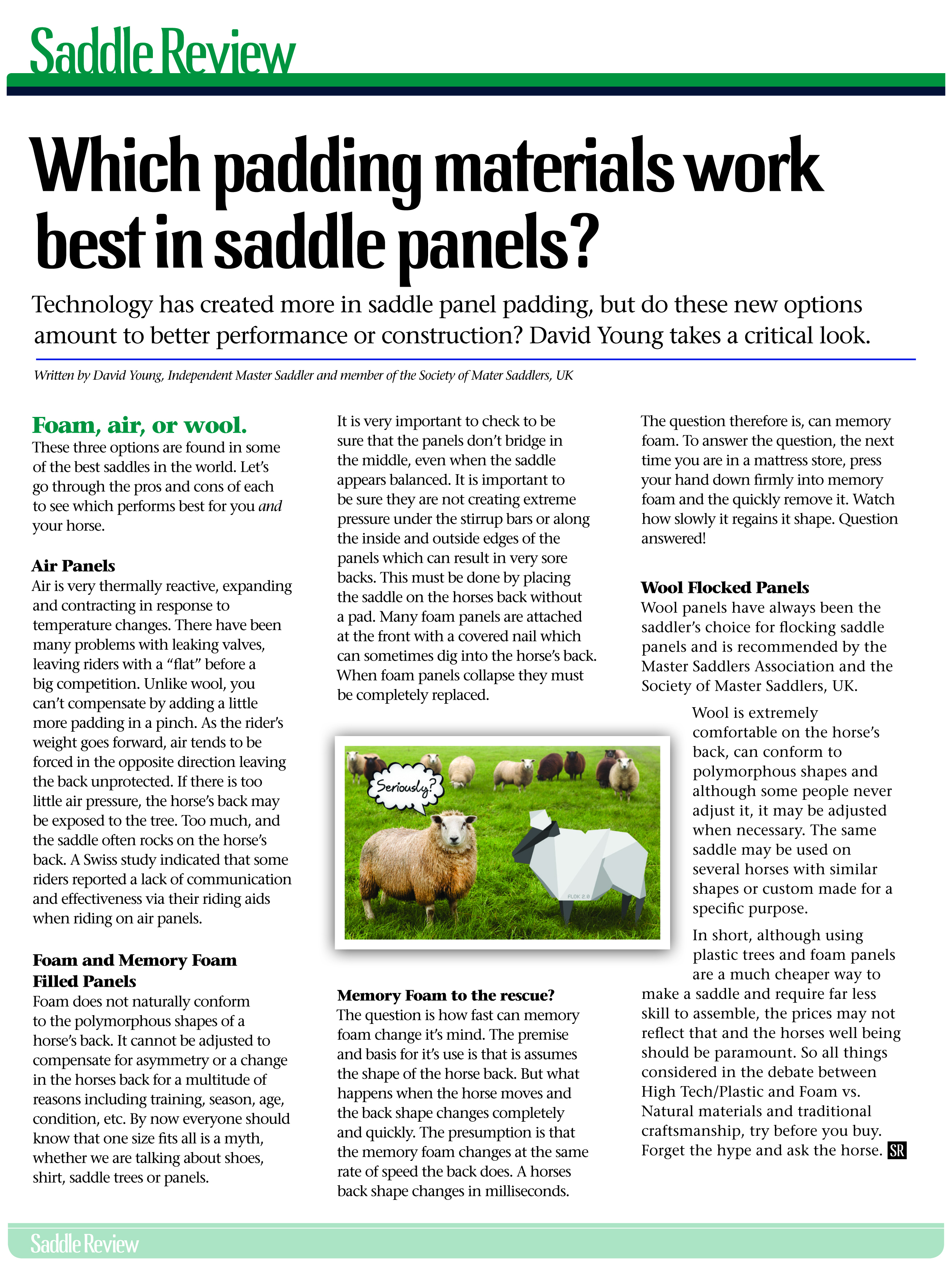Which Padding Materials Work Best In Saddle Panels?

Which padding works best in saddle panels… Wool or foam?
Technology has created more options, but does high tech amount to better construction
or performance, or just cheaper production costs? Let’s take a critical look.
Written by David Young, Independent British Master Saddler. David Young has worked on virtually every make and model of saddle on the planet.
Here are his thoughts on what works best for the horse.
Foam/Memory Foam, Wool and Air.
Foam and Wool are found in some of the best known saddles in the world,
with air rarely used. Let’s go through the pros and cons of each to see which
performs best for you and your horse.
Air Panels
Air is very thermally reactive, expanding
and contracting in response to temperature, literally changing
the panel shape. There have been many problems with leaking valves,
sometimes leaving riders with a “flat” before a big competition. Unlike wool,
you can’t compensate by adding a little more padding in a pinch. As the
rider’s weight goes forward the air tends to be forced in the opposite direction
leaving the back unprotected. If there is too little air pressure, the horse’s back
may be exposed to the tree. Too much pressure, and the saddle often rocks on
the horse’s back. A Swiss study indicated that some riders reported a lack of
communication and effectiveness via their riding aids when riding on air
panels. For these reasons air is the least often used in saddle panels.
Foam Panels
Foam panels are often pitched as the panel that doesn’t have to be adjusted.
The fact is they can’t be adjusted. Foam panels are virtually all the same shape
because they are pre-formed. The problem is every horse’s back is different.
Foam does not naturally conform to the polymorphous shape of a horse’s back.
It can’t be adjusted to compensate for asymmetry stemming from a variety of
causes such as conformation, condition,change in work or season, or injury. It is
important to check for bridging in the middle, even when the saddle appears
balanced. Like all panels, foam panels compress over time and may create
uncomfortable pressure on the horse’s back and withers, causing
soreness. When this happens, the panels should be completely replaced.
Foam panels can have hard edges that fail to distribute the
rider’s weight evenly over a broad surface
area. Many foam panels are attached at the
front with a covered nail which can sometimes dig into
the horse’s back. Using stacks of pads does not compensate for a saddle that
doesn’t fit regardless of what the panels are made of. Bottom line is there is no
such thing as one size fits all!
Wool Flocked Panels
Wool has always been, and continues to be, the saddler’s
choice for flocking panels. Wool is extremely comfortable on the
horse’s back and facilitates even weight distribution. Wool consists
of long short and individual strands that easily conform to the shapes
of the horse’s back and can be easily adjusted to compensate for
asymmetry in the horse’s back.
Wool can be completely replaced in older saddles for relatively little cost
without having to replace the panel itself. It provides stable support
for the rider’s weight. Wool panels may need to be periodically topped
off or adjusted to compensate for compression or changes in the
horse’s condition; typically once or twice a year. A small price to pay for
soundness and optimal performance.
It is important to note that none of the panel materials discussed
above can compensate for a poorly designed saddle. But at the end of
the day don’t just take my word for it, forget about all the hype and
listen to your horse.
Recent Posts
-
SADDLE FITTING CLINIC
29th Nov 2025 -
SADDLE FITTING CLINIC
7th Nov 2025 -
